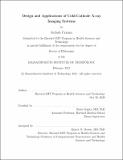| dc.contributor.advisor | Rajiv Gupta. | en_US |
| dc.contributor.author | Cramer, Avilash(Avilash Kalpathy) | en_US |
| dc.contributor.other | Harvard--MIT Program in Health Sciences and Technology. | en_US |
| dc.date.accessioned | 2021-05-24T19:52:38Z | |
| dc.date.available | 2021-05-24T19:52:38Z | |
| dc.date.copyright | 2021 | en_US |
| dc.date.issued | 2021 | en_US |
| dc.identifier.uri | https://hdl.handle.net/1721.1/130711 | |
| dc.description | Thesis: Ph. D., Harvard-MIT Program in Health Sciences and Technology, September, February, 2021 | en_US |
| dc.description | Cataloged from the official PDF version of thesis. | en_US |
| dc.description | Includes bibliographical references (pages 145-159). | en_US |
| dc.description.abstract | X-ray computed tomography (CT) and planar x-ray imaging are mainstays of modern clinical care. The electron generation mechanism in standard x-ray tubes - specifically, a thermionic cathode - is reliable and capable of high current. However, thermionic cathodes are bulky, and cannot be pulsed quickly. Non-thermionic ('cold-cathode') electron generation can be exploited to make a smaller and rapidly pulsable x-ray source. Such an x-ray source could improve not just the portability of x-ray devices, but would allow for a CT system to operate by pulsing a distributed ring of x-ray sources instead of rotating a single large x-ray source. Furthermore, cold-cathode x-ray sources could allow for new signal acquisition and processing paradigms in the x-ray domain. This includes time-based image acquisition techniques, such as elastography and photon-counting measurements. In this dissertation, I discuss (1) the development of two novel types of cold-cathode x-ray sources: an ultraviolet photocathode-based source, and a silicon field emission chip; (2) novel methods for planar x-ray image acquisition, including a demonstration of dynamic x-ray elastography using a pulsed photocathode x-ray source; and (3) applications of modern signal processing techniques to the tomographic image reconstruction problem. In an epilogue, I discuss our research on N95 respirator sterilization and re-use for crisis situations. | en_US |
| dc.description.statementofresponsibility | by Avilash Cramer. | en_US |
| dc.format.extent | 159 pages | en_US |
| dc.language.iso | eng | en_US |
| dc.publisher | Massachusetts Institute of Technology | en_US |
| dc.rights | MIT theses may be protected by copyright. Please reuse MIT thesis content according to the MIT Libraries Permissions Policy, which is available through the URL provided. | en_US |
| dc.rights.uri | http://dspace.mit.edu/handle/1721.1/7582 | en_US |
| dc.subject | Harvard--MIT Program in Health Sciences and Technology. | en_US |
| dc.title | Design and applications of cold-cathode X-ray imaging systems | en_US |
| dc.type | Thesis | en_US |
| dc.description.degree | Ph. D. | en_US |
| dc.contributor.department | Harvard University--MIT Division of Health Sciences and Technology | en_US |
| dc.identifier.oclc | 1251801720 | en_US |
| dc.description.collection | Ph.D. Harvard-MIT Program in Health Sciences and Technology | en_US |
| dspace.imported | 2021-05-24T19:52:38Z | en_US |
| mit.thesis.degree | Doctoral | en_US |
| mit.thesis.department | HST | en_US |
